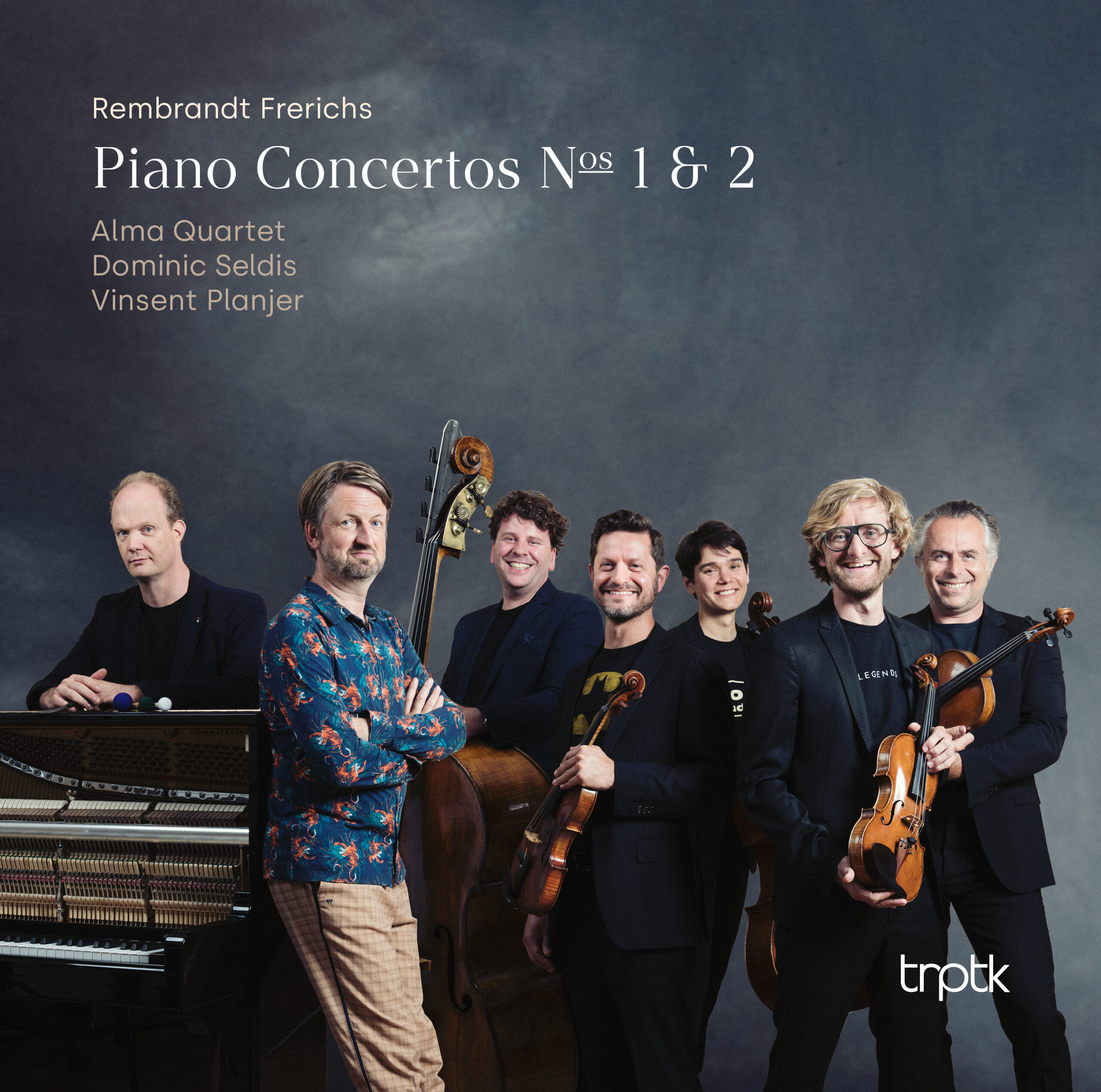It is a logical consequence of his artistic choices over the past decade that Rembrandt has come to be known as a forward-thinking free spirit for musicians who want to break out of the confines of their professional practice.
Rembrandt Frerichs, Alma Quartet, Dominic Seldis & Vinsent Planjer
Frerichs: Piano Concertos Nos. 1 & 2
About the album
For pianist and composer Rembrandt Frerichs (1977), a new musical adventure began when viola player Michael Gieler invited him for an open conversation. Gieler is a solo violist with the Royal Concertgebouw Orchestra and leader of the IJ-Salon series, a cross-border ‘playground’ of chamber music with musicians of the Royal Concertgebouw Orchestra. Gieler planted a seed that grew into a composition commission for Rembrandt’s first Piano Concerto. Rembrandt took up the challenge.
Rembrandt Frerichs already came into the spotlight through composition commissions from leading musicians, including Liza Ferschtman and Amsterdam Sinfonietta. His star is rising further now that musicians of the Royal Concertgebouw Orchestra have asked him to compose a brand new piano concerto that features himself as soloist.
It is a logical consequence of his artistic choices over the past decade that Rembrandt has come to be known as a forward-thinking free spirit for musicians who want to break out of the confines of their professional practice. In his projects, he makes every effort to test both his own limits and those of his fellow musicians. On this album this can be heard, for example, on the track “Finale,” where the strings are plunged into a rhythmic world not yet common to classical musicians.
Rembrandt: “Mahler’s Fourth is well-known territory for these musicians. We have known for a hundred years what it is supposed to sound like. For improvising musicians, everything they make is living material that can constantly change. We afford ourselves more liberties. And we know, the wrong note is where the adventure begins! In the second piano concerto, you can hear a great example of living material in the 3rd movement when the strings hold a long note and they have no idea what I’m going to do with that note.”
It’s easy to forget, but imagine that you could travel in a time machine to a Beethoven or Mozart concert and you would notice that Ludwig and Wolfgang mainly played their own work. Moreover, they often did not have a notated piano score. Later, one of these performances was transcribed and notated for publishing purposes. This score, passed on from generation to generation, has led to the widespread misconception that in what we now call classical music all the notes were always the same.
The approach Rembrandt takes here goes back to the original performance practice of the great masters. It shows that classical and jazz are not as far apart as is often thought.
As in their time, a performance of the piano concerto is an experience of tailor- made music for the individual piano soloist. Because of the improvisations, no two concerts are the same. An illustrative example of this is the 3rd movement of the first piano concerto “Musique au font”, where a joint improvisation begins from 3:20.
Rembrandt: “For a long time it was unclear how the concert would sound in its entirety. The string players didn’t have a picture of the embedding of the piano yet. At the rehearsals I would say something like: I’m going to do something here, but what that is I’ll figure out during the concert. The penny didn’t drop until we played for an audience for the first time at the Oranjewoud festival and the musicians heard the piece in its entirety. You could truly read on their faces, ‘Aaaah so this is what he meant…’ That moment can be heard during the second movement of the piano concerto no. 2.”
As a listener, you experience the musical battle between ensemble and piano; an exhilarating ritual dance of two partners. A new path is taken as improviser Rembrandt combines the best of two worlds with the classical musicians on stage. As with Ravel, Debussy and Gershwin, the composer himself sits at the piano.
Rembrandt: “I want to take the audience into my ‘Black page / white page’ approach, which is to say that the listener is aware that the classical musicians on stage have an actual part with black dots on paper. I, on the other hand, have a completely blank page. I re-imagine the conversation with the orchestra each concert, providing musical commentary and a counterpoint, as on ‘Cadenza 2’ from the first piano concerto. Classical pianists play from a score. With my piano concerto, I take a clear stand in order to shake up performance practice by involving the audience in the creation process. In doing so, I am following the practice of both Mozart and Beethoven, who usually did not write out their piano parts either: they knew the parts of all the other instruments by heart but only created their parts during the concert. My starting point in this is my many years of improvised jazz background, which I bring to the fore in the last movement of the 1st piano concert, ‘Blue Pencilled Outlines’. In how this comes together, that adventure, we take the listener with us during our concerts.”
Tracklist click to play/pause
-
Rembrandt Frerichs
Piano concerto No. 1
-
Textures and Registers
3:393:39
-
Cadenza I
2:322:32
-
Bohemia Theme
4:564:56
-
Cadenza II
2:472:47
-
Elasticity
3:533:53
-
A Wind Invisible Sweeps Us Through The World
5:375:37
-
Musique Au Font
9:299:29
-
Blue Pencilled Outlines
7:137:13
-
-
Rembrandt Frerichs
Piano concerto No. 2
-
1st Movement
5:475:47
-
2nd Movement
4:234:23
-
3rd Movement
6:196:19
-
4th Movement
3:263:26
-
More information
| Label | TRPTK |
|---|---|
| Genre(s) | Classical – Contemporary (> 1920) Jazz |
| Artist(s) | Alma Quartet Dominic Seldis Rembrandt Frerichs Vinsent Planjer |
| Composer(s) | Frerichs, Rembrandt |
| Recording location(s) | Studio 150 Bethlehemkerk, Amsterdam (NL) |
| Recording date(s) | December 2021 |
| Cat. No. | TTK 0088 |
|---|---|
| Release date |
December 1st, 2023 |
| Additional links |
"There is a constant, exhilarating ritual dance going on between ensemble and piano. These two partners contest with one another, occasionally coalesce with one another. But there is always a strong dynamic tension generating drama and engagement. The ensemble has a score, black dots on paper, to follow. Their path is defined. Frerichs, on the other hand, has a blank page. It is unfair. It is also very engaging for the listener wondering what might come next."
Rush Paul, Positive Feedback
"Rembrandt Frerichs departs from traditional jazz patterns, ensuring that his work is communicative and enjoyable for both listeners and performers. The music we hear here is full of lightness, temperament and spaciousness. Perfectly played and great sounding solo parts are very ordered and you don't hear at the first moment that they are improvised. It is an extraordinary project, a unique album, a jewel, a "must have" for any fan of good music."
Jacek Brun, Jazz Fun
"The end result sounds magnificent, and in fact that comment applies to the complete CD. Class, as the strings in the third movement pick up the beautiful piano solo. Very classical in fact, just like the transition to the final piece, which starts off in an easterly atmosphere. There is no lack of musical highlights. Once again, TRPTK knows how to distinguish itself among the adventurous music labels."
Maarten-Jan Dongelmans, De Gelderlander
"Rembrandt Frerichs lets the classical guys jam too!"
Sandra Kooke, Trouw
"I love this entire album for Frerichs beautiful compositions, playing, sound quality, and the immersive mix."
Chris Connaker, Audiophile Style
"This is a musical candy store!"
Johan Bakker, Nederlands Dagblad
"The mix of the playful jazz piano and the strings, which have a classical feel but also like to indulge in modern sounds, is not always easy to consume. In the end, however, it is a successful recording by very accomplished musicians. A new path is taken when the improviser Rembrandt combines the best of two worlds with the classical musicians on stage. As with Ravel, Debussy and Gershwin, the composer himself sits at the piano. As a listener, one experiences the musical competition between ensemble and piano, an intoxicating ritual dance of two partners."
Music Headquarter
"An exciting meeting between jazz musicians who treat a wrong note as the beginning of a new adventure with classical musicians who play by a score and are challenged by such liberties."
Eyal Hareuveni, Salt Peanuts
"Besides his gifts as a pianist and composer, Frerichs also possesses the talent to hold one's attention."
Coen de Jonge, Jazzism
"Rembrandt Frerichs realizes his most ambitious project to date with his Piano Concertos. It demands intense attention from the listener because of the sublime total experience. Listening to it again and again is essential in order to fully absorb the complexities of this musical fusion. A top album, warmly recommended!"
Bernard Lefèvre, Jazz Halo
"Frerichs continually presents the strings with new themes or challenges them with angular rhythms. Sometimes they join in, sometimes they timidly withdraw. Or everyone goes their own way in a stylistic cross between late romantic melancholy and jazzy composure. And all of this performed with an incredible amount of flair and finesse."
Jenny Camilleri, De Volkskrant
"The music is tastefully blended, varying from free to strongly rhythmic, stylistically bound to eclectically mixed, minute by minute, its structure built up linearly from small units laid out in mosaic-like juxtaposition. [...] The disc is highly recommended for anyone who enjoys a colourful, genre-rich musical style, sophisticated chamber music and, of course, the occasional jazz section. Let's go on an adventure!"
Németh Márta, JazzMa
Related products
-
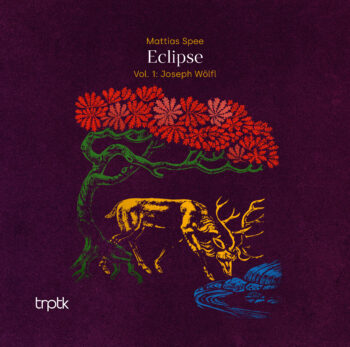
Eclipse, Vol. 1: Joseph Wölfl
Mattias Spee
Spatial Audio Download
€ 25,00 | TTK0073 -
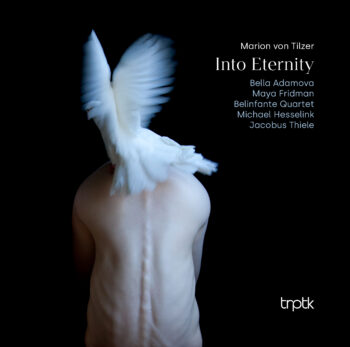
Into Eternity
Marion von Tilzer
Bella Adamova
Maya Fridman
Belinfante Quartet
Michael Hesselink
Jacobus ThieleSpatial Audio Download
€ 25,00 | TTK0104 -
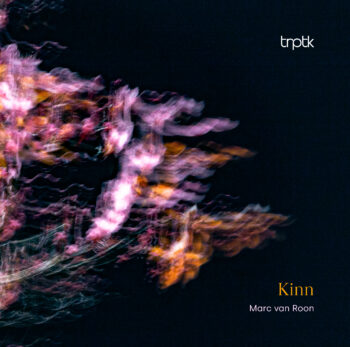
Kinn
Marc van Roon
Spatial Audio Download
€ 25,00 | TTK0091 -

Eclipse, Vol. 2: Hans Henkemans
Mattias Spee
South Netherlands Philharmonic Orchestra
Ed SpanjaardSpatial Audio Download
€ 25,00 | TTK0102 -

Gandhaya
Gandhaya Quartet
Spatial Audio Download
€ 12,50 | TTK0108 -
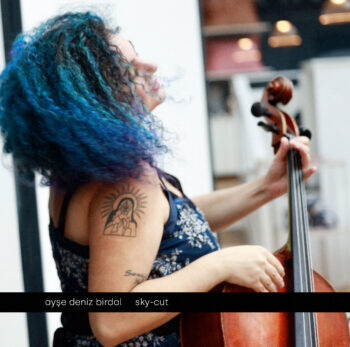
Sky-Cut
Ayşe Deniz Birdal
Spatial Audio Download
€ 25,00 | TTX0002


